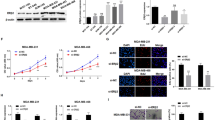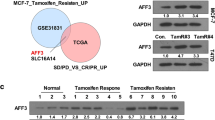Abstract
Background
Tamoxifen is a first-line endocrine agent and is often used to treat estrogen receptor-positive (ER+) breast cancer. Unfortunately, approximately 30-40% of patients who received tamoxifen therapy experience recurrence or progression to a fatal advanced stage due to tamoxifen resistance. However, the mechanisms of tamoxifen resistance remain unclear.
Methods
The expression of lncRNA DLGAP1 antisense RNA 2 (DLGAP1-AS2) was detected by qPCR. The effect of DLGAP1-AS2 on tamoxifen resistance was evaluated by MTT, colony formation, TUNEL and flow cytometric assays. The mechanisms by which DLGAP1-AS2 regulates tamoxifen resistance were investigated through qPCR, RNA pull-down assays and RNA immunoprecipitation (RIP) assays.
Results
Our results showed that DLGAP1-AS2 is significantly upregulated in breast cancer and that tamoxifen can induce DLGAP1-AS2 expression. Further investigation suggested that upregulation of DLGAP1-AS2 can increase cell viability and inhibit apoptosis, while downregulation of DLGAP1-AS2 results in the opposite effects. Mechanistically, DLGAP1-AS2 can bind to the AFF3 protein to inhibit its degradation, which further promotes ER signalling.
Conclusions
Our research clarified that DLGAP1-AS2 promotes ER signalling to induce tamoxifen resistance and that targeting DLGAP1-AS2 might be a promising strategy to overcome tamoxifen resistance in breast cancer.





Similar content being viewed by others
Availability of data and materials:
The data that support the findings of this study are available from the corresponding author upon reasonable request.
References
Sung H, Ferlay J, Siegel RL, Laversanne M, Soerjomataram I, Jemal A, Bray F (2021) Global Cancer Statistics 2020: GLOBOCAN Estimates of Incidence and Mortality Worldwide for 36 Cancers in 185 Countries. CA Cancer J Clin 71:209–249. https://doi.org/10.3322/caac.21660
Musgrove EA, Sutherland RL (2009) Biological determinants of endocrine resistance in breast cancer. Nat Rev Cancer 9:631–643. https://doi.org/10.1038/nrc2713
Early Breast Cancer Trialists’, Collaborative G, Davies C, Godwin J, Gray R, Clarke M, Cutter D, Darby S, McGale P, Pan HC, Taylor C, Wang YC, Dowsett M, Ingle J, Peto R (2011) Relevance of breast cancer hormone receptors and other factors to the efficacy of adjuvant tamoxifen: patient-level meta-analysis of randomised trials. Lancet 378:771–784. https://doi.org/10.1016/S0140-6736(11)60993-8
Early Breast Cancer Trialists’ Collaborative Group (1998) Tamoxifen for early breast cancer: an overview of the randomised trials. Lancet 351: 1451–1467. https://doi.org/10.1016/S0140-6736(97)11423-4
Cuzick J, Forbes JF, Sestak I, Cawthorn S, Hamed H, Holli K, Howell A, ,International Breast Cancer Intervention Study II (2007) Long-term results of tamoxifen prophylaxis for breast cancer--96-month follow-up of the randomized IBIS-I trial. J Natl Cancer Inst 99:272–282. https://doi.org/10.1093/jnci/djk049
Ye L, Lin C, Wang X, Li Q, Li Y, Wang M, Zhao Z, Wu X, Shi D, **ao Y, Ren L, Jian Y, Yang M, Ou R, Deng G, Ouyang Y, Chen X, Li J, Song L (2019) Epigenetic silencing of SALL2 confers tamoxifen resistance in breast cancer. EMBO Mol Med 11:e10638. https://doi.org/10.15252/emmm.201910638
Fang Y, Fullwood MJ (2016) Roles, Functions, and Mechanisms of Long Non-coding RNAs in Cancer. Genomics Proteom Bioinf 14:42–54. https://doi.org/10.1016/j.gpb.2015.09.006
Schmitt AM, Chang HY (2016) Long Noncoding RNAs in Cancer Pathways. Cancer Cell 29:452–463 https://doi.org/10.1016/j.ccell.2016.03.010
Shi Q, Li Y, Li S, ** L, Lai H, Wu Y, Cai Z, Zhu M, Li Q, Li Y, Wang J, Liu Y, Wu Z, Song E, Liu Q (2020) LncRNA DILA1 inhibits Cyclin D1 degradation and contributes to tamoxifen resistance in breast cancer. Nat Commun 11:5513. https://doi.org/10.1038/s41467-020-19349-w
Li J, Meng H, Bai Y, Wang K (2016) Regulation of lncRNA and Its Role in Cancer Metastasis. Oncol Res 23:205–217. https://doi.org/10.3727/096504016X14549667334007
Gupta RA, Shah N, Wang KC, Kim J, Horlings HM, Wong DJ, Tsai MC, Hung T, Argani P, Rinn JL, Wang Y, Brzoska P, Kong B, Li R, West RB, van de Vijver MJ, Sukumar S, Chang HY (2010) Long non-coding RNA HOTAIR reprograms chromatin state to promote cancer metastasis. Nature 464:1071–1076. https://doi.org/10.1038/nature08975
Kim K, Jutooru I, Chadalapaka G, Johnson G, Frank J, Burghardt R, Kim S, Safe S (2013) HOTAIR is a negative prognostic factor and exhibits pro-oncogenic activity in pancreatic cancer. Oncogene 32:1616–1625. https://doi.org/10.1038/onc.2012.193
Geng YJ, **e SL, Li Q, Ma J, Wang GY (2011) Large intervening non-coding RNA HOTAIR is associated with hepatocellular carcinoma progression. J Int Med Res 39:2119–2128. https://doi.org/10.1177/147323001103900608
Miao W, Li N, Gu B, Yi G, Su Z, Cheng H (2020) LncRNA DLGAP1-AS2 modulates glioma development by up-regulating YAP1 expression. J Biochem 167:411–418. https://doi.org/10.1093/jb/mvz108
Chen K, Zhang Z, Yu A, Li J, Liu J, Zhang X (2020) LncRNA DLGAP1-AS2 Knockdown Inhibits Hepatocellular Carcinoma Cell Migration and Invasion by Regulating miR-154-5p Methylation. Biomed Res Int. 2020: 6575724. https://doi.org/10.1155/2020/6575724
Wang Y, Yang L, Chen T, Liu X, Guo Y, Zhu Q, Tong X, Yang W, Xu Q, Huang D, Tu K (2019) A novel lncRNA MCM3AP-AS1 promotes the growth of hepatocellular carcinoma by targeting miR-194-5p/FOXA1 axis. Mol Cancer 18:28. https://doi.org/10.1186/s12943-019-0957-7
Yang H, Cho ME, Li TW, Peng H, Ko KS, Mato JM, Lu SC (2013) MicroRNAs regulate methionine adenosyltransferase 1A expression in hepatocellular carcinoma. J Clin Invest 123:285–298. https://doi.org/10.1172/JCI63861
Zhang J, Li Z, Liu L, Wang Q, Li S, Chen D, Hu Z, Yu T, Ding J, Li J, Yao M, Huang S, Zhao Y, He X (2018) Long noncoding RNA TSLNC8 is a tumor suppressor that inactivates the interleukin-6/STAT3 signaling pathway. Hepatology 67:171–187. https://doi.org/10.1002/hep.29405
Shi Y, Zhao Y, Zhang Y, AiErken N, Shao N, Ye R, Lin Y, Wang S (2018) AFF3 upregulation mediates tamoxifen resistance in breast cancers. J Exp Clin Cancer Res 37:254. https://doi.org/10.1186/s13046-018-0928-7
Early Breast Cancer Trialists’ Collaborative G (2015) Aromatase inhibitors versus tamoxifen in early breast cancer: patient-level meta-analysis of the randomised trials. Lancet 386:1341–1352. https://doi.org/10.1016/S0140-6736(15)61074-1
Liu Y, Li M, Yu H, Piao H (2020) lncRNA CYTOR promotes tamoxifen resistance in breast cancer cells via sponging miR125a5p. Int J Mol Med 45:497–509. https://doi.org/10.3892/ijmm.2019.4428
Kim CY, Oh JH, Lee JY, Kim MH (2020) The LncRNA HOTAIRM1 Promotes Tamoxifen Resistance by Mediating HOXA1 Expression in ER+ Breast Cancer Cells. J Cancer 11:3416–3423. https://doi.org/10.7150/jca.38728
Mills JN, Rutkovsky AC, Giordano A (2018) Mechanisms of resistance in estrogen receptor positive breast cancer: overcoming resistance to tamoxifen/aromatase inhibitors. Curr Opin Pharmacol 41:59–65. https://doi.org/10.1016/j.coph.2018.04.009
Wang ZY, Yin L (2015) Estrogen receptor alpha-36 (ER-alpha36): A new player in human breast cancer. Mol Cell Endocrinol 418 Pt 3:193–206. https://doi.org/10.1016/j.mce.2015.04.017
Xue X, Yang YA, Zhang A, Fong KW, Kim J, Song B, Li S, Zhao JC, Yu J (2016) LncRNA HOTAIR enhances ER signaling and confers tamoxifen resistance in breast cancer. Oncogene 35:2746–2755. https://doi.org/10.1038/onc.2015.340
Gao A, Sun T, Ma G, Cao J, Hu Q, Chen L, Wang Y, Wang Q, Sun J, Wu R, Wu Q, Zhou J, Liu L, Hu J, Dong JT, Zhu Z (2018) LEM4 confers tamoxifen resistance to breast cancer cells by activating cyclin D-CDK4/6-Rb and ERalpha pathway. Nat Commun 9:4180. https://doi.org/10.1038/s41467-018-06309-8
Funding
The study is supported by the National Natural Foudation of China (No. 81902675, Recipient: Yawei Shi); the Natural Science Foudation of Guangdong Province (No. 2021A1515010333, Recipient: Yawei Shi); the Guangdong Medical Science and Technology Foundation (No.A2018069, Recipient: Yawei Shi).
Author information
Authors and Affiliations
Contributions
YMS and LY designed the research. DYZ, MMZ, YZ and ZF performed the experiments. NS performed the statistical analysis. XLL and YZ collected the data and wrote the paper. All authors read and approved the final content of the study.
Corresponding authors
Ethics declarations
Conflict of interest
The authors declare that they have no competing interests.
Ethical approval:
The manuscript has not been previously published or submitted in whole or in part elsewhere. Before gathering the patient tissues for research, the approval from the Institutional Ethics Committee of the First Affiliated Hospital of Sun Yat-sen University were obtained.
Consent for publication:
Before collecting human specimens, we obtained patient consent and approval from the Institutional Research Ethics Committee of the First Affiliated Hospital of Sun Yat-sen University.
Consent for publication:
All authors read the final manuscript and agreed on the publication.
Additional information
Publisher’s Note
Springer Nature remains neutral with regard to jurisdictional claims in published maps and institutional affiliations.
Electronic Supplementary Material
Below is the link to the electronic supplementary material.
Rights and permissions
About this article
Cite this article
Liang, X., Zhao, Y., Fang, Z. et al. DLGAP1-AS2 promotes estrogen receptor signalling and confers tamoxifen resistance in breast cancer. Mol Biol Rep 49, 3939–3947 (2022). https://doi.org/10.1007/s11033-022-07244-0
Received:
Revised:
Accepted:
Published:
Issue Date:
DOI: https://doi.org/10.1007/s11033-022-07244-0




